|
|
Dear Colleagues
These days one often reads headlines like "data is the new gold". For scientists however this is nothing new. Data has always been at the center of research activities. What was sometimes lacking was the effort to annotate and curate the data long-term.
Therefore in recent years many activities started to deal with data annotation, preservation and publishing.
|

Stephan Egli
|
|
They support the Principal Investigator and her team to keep track of their own data, but they can also have several positive side effects: data can be shared and re-used by other scientists, the data can be re-analyzed and verified through better algorithms and, if openly accessible, can be used in completely unforeseen ways, e.g. for cross-disciplinary investigations.
The necessary data catalog infrastructure was implemented with help from the DAAS project, followed by the "Data Curation" project within the PSI-ESS collaboration resulting in both the software SciCat and hardware infrastructure of the CSCS-Petabyte Archive, and the integration into the processes of the Digital User Office.
Since more than three years scientists at PSI can now annotate, preserve and also publish their data, with volumes in the PB regime, using the SciCat installation. In the meantime the SciCat software is further developed by a lively international community. PSI published a Data Policy to govern these processes consistent with the FAIR principles.
Recently the ETH domain has started the ETH-ORD program to support open research data solutions across the whole ETH domain. It is followed by the Swiss Open Research Data Grants program.
One of the remaining challenges is to achieve a high quality and standardization of the metadata, ideally at an international level, like in NeXus. These activities must however be driven from within the science communities. Ideally these activities are progressing well to be ready for the start of data taking at SLS 2.0 in 2025.
Stephan Egli
PSI Scientific Computing Division, on behalf of the Data Curation group
|
|
Next proposal submission deadlines:
SwissFEL
deadline: 15 September 2022
more information
SLS: non-PX beamlines
deadline: 15 September 2022
more information
SLS: PX beamlines
deadline: 15 October 2022
more information
SINQ
deadline: 15 November 2022
more information
SµS
deadline: 1 December 2022
more information
CHRISP
deadline: January 2023 (tbd)
more information
An overview of all proposal submission deadlines of the PSI facilities can be found here.
|
|
|
Three-dimensional vortex gyration dynamics unraveled by time-resolved soft X-ray laminography
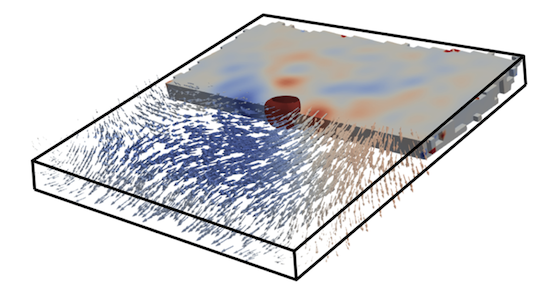 SLS — Into the fourth dimension SLS — Into the fourth dimension
Three-dimensional magneto-dynamical processes give rise to rich dynamical behavior and might enable novel functionalities for devices. However, in imaging experiments such processes can be typically characterized only indirectly, not least as there is no technique available for resolving the dynamics both in time and along all three spatial dimensions. That is, until now. A team led by PSI researchers, working at the PolLux endstation of SLS, has combined pump–probe STXM imaging with soft X-ray magnetic laminography. With this approach they are able to resolve magnetization dynamics in four dimensions, as they exemplified in an investigation of two resonant dynamical modes of a CoFeB microstructure. For X-ray detection, an avalanche photodiode is used, which means that excitations of arbitrary frequencies can be studied — thereby overcoming a major limitation of current techniques in which the acquisition of single projections relies on two-dimensional X-ray detectors.
Read the full story |
|
|
S. Finizio et al., Nano Letters 5, 1971 (2022)
|
|
|
Fast room-temperature Mg2+ conductivity in Mg(BH4)2·1.6NH3−Al2O3 nanocomposites
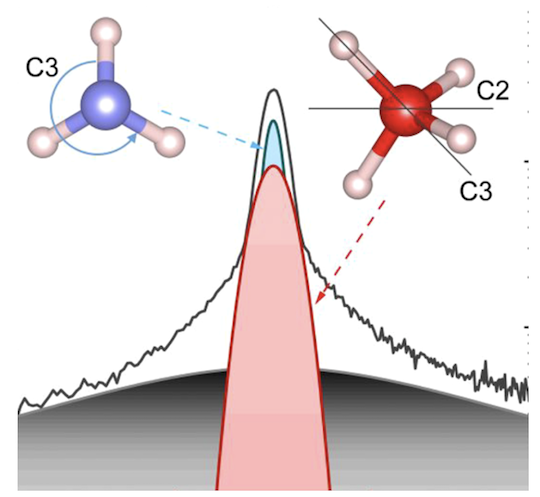 SINQ — Towards solid-state magnesium batteries SINQ — Towards solid-state magnesium batteries
Magnesium-metal batteries are promising candidates for future energy-storage devices beyond the well-established Li-ion technologies. However, progress towards a competitive magnesium battery is hindered by a lack of efficient and stable Mg-ion electrolytes. An international team of researchers now reports a novel route to boosting conductivity in the solid-state electrolyte Mg(BH4)2·1.6NH3, which has emerged as a promising material for operation at practically relevant temperatures. Combining several characterization methods, including quasielastic neutron scattering (QENS) measurements performed at the time-of-flight spectrometer FOCUS of SINQ, the team demonstrates that adding insulating Al2O3 nanopowder to Mg(BH4)2·1.6NH3 can substantially improve the ionic conductivity, in particular at room temperature. Moreover, the QENS analysis revealed a similar activation energy for Mg-ionic migration and NH3 rotations — suggesting a mechanism how the neutral NH3 molecules assist Mg2+ migration.
|
|
|
Y. Yan et al., Journal of Physical Chemistry Letters 13, 2211 (2022)
|
|
|
First demonstration of tuning between the Kitaev and Ising limits in a honeycomb lattice
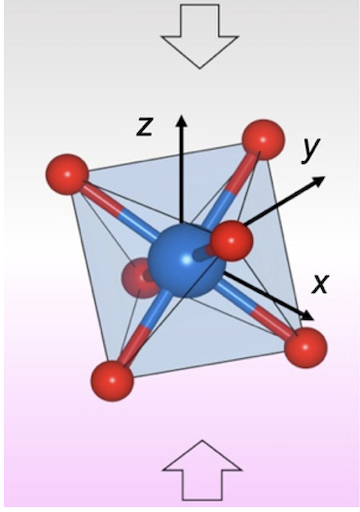 SμS — A new spin–orbital state SμS — A new spin–orbital state
In recent years, there has been growing interest in 4 d/5 d transition-metal systems, fueled by observations of novel spin–orbit-coupled states. A prime example is the so-called Jeff= ½ state in honeycomb iridate materials and α-RuCl 3, which has been shown to drive Kitaev interactions. An international team of researchers now introduce a new spin–orbital state in a honeycomb structure — one that drives Ising instead of Kitaev interactions. The new state emerges through restructuring the spin–orbital wave functions by tuning the interplay between spin–orbit interaction and trigonal crystal field, as achieved in a topochemical reaction converting Li 2RhO 3 to Ag 3LiRh 2O 6. By combining first-principles calculations with magnetization measurements, muon spin relaxation — performed at SμS — and X-ray absorption spectroscopy, the team establishes that their system provides the first example of successful tuning between the Kitaev and Ising limits in the same material family.
Read the full story |
|
|
F. Bahrami et al., Science Advances 8, eabl5671 (2022)
|
|
|
Time-resolved X-ray spectroscopy to study luminophores with relevance for OLEDs
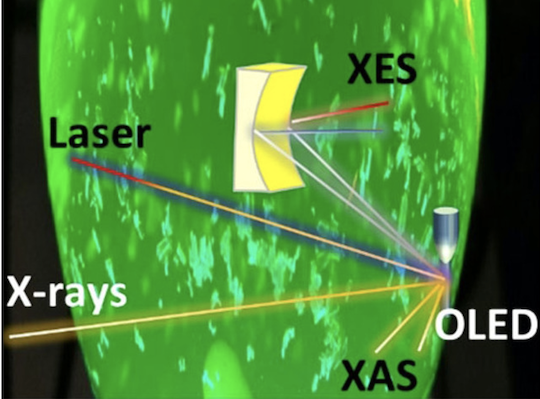 SwissFEL — Shedding light on new OLED materials SwissFEL — Shedding light on new OLED materials
Organic light-emitting diodes (OLEDs) have become ‘must-have’ displays for consumer goods, from handheld smartphones to large-area TV screens. Unsurprisingly, further developments are in the pipeline. The newest generation of OLED emitters is based on coordination entities with abundant, inexpensive metal centers, mainly copper. PSI beamline scientist Grigory Smolentsev and Matthias Vogt from the University of Halle-Wittenberg now discuss in a review article how time-resolved X-ray spectroscopy can provide unique insight into such luminophores based on metal complexes. In particular, determining their excited-state structures is important, for understanding non-radiative losses. Such insight, in turn, should help to develop more efficient luminophores. Among different time-resolved techniques, they focus on methods using synchrotron radiation that cover the time range from 100 ps to microseconds, and highlight first results and perspectives of experiments using X-ray free electron lasers.
|
|
|
M. Vogt & G. Smolentsev, ChemPhotoChem 6, e202100180 (2022)
|
|
|
Search for a muon EDM using the frozen-spin technique
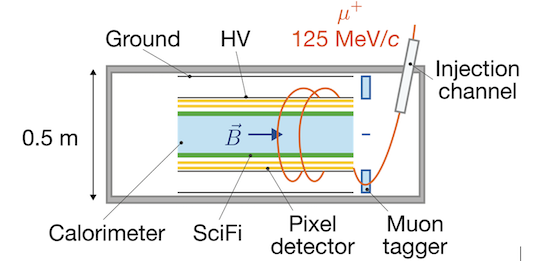 CHRISP — Groundwork laid CHRISP — Groundwork laid
An international team of scientists has laid the groundwork for a dedicated experiment to search for the muon electric dipole moment (EDM) at PSI. This search will provide insight into the violation of charge–parity symmetry in muons, and could corroborate hints for new physics observed in the muon g-2 and semileptonic B-decays. In 2020, researchers from more than 20 institutions discussed at PSI key ideas for a novel experiment based on the frozen-spin technique. A year later, the CHRISP research committee welcomed the letter of intent, submitted by the initiative. Now, boosted by an ERC Consolidator grant awarded to Dr. Philipp Schmidt-Wellenburg, the members of the future collaboration met in May 2022 in Pisa. In an initial phase, the collaboration strives to implement the frozen-spin technique in a compact solenoid, with the goal of demonstrating a 30-times higher sensitivity to the muon EDM than in any previous experiment. Prospects for further improvements include in particular the use of the new high-intensity muon beams at PSI ( HIMB).
|
|
|
A. Adelmann et al., Preprint at arXiv:2102.08838
|
|
|
News from the user facilities
|
|
|
Hercules School 2022
SLS-SINQ-SμS
In the week of 21–25 March 2022, we had the pleasure of welcoming online 20 international PhD students, postdocs and scientists for the Hercules School on Neutrons and Synchrotron Radiation. The participants attended online lectures, virtual tours and remote practicals given by SLS, SINQ and SμS staff. The school is dedicated to introducing scientists to new techniques and methods at large-scale facilities utilizing photons, neutrons and muons, and covers multiple disciplines, including biology, chemistry, physics, material science and industrial applications.
More information |
|
High-spatial-resolution measurements with a GaAs:Cr sensor
SLS
PSI researchers report first imaging experiments performed with a 25 μm pixel pitch GaAs:Cr sensor of 500 μm thickness bump-bonded to the charge-integrating MÖNCH 03 readout chip developed at PSI. In experiments at the TOMCAT beamline of SLS, carried out in the energy range of 10–30 keV, a spatial resolution of ∼5 μm was obtained at 16 keV when applying a suitable interpolation algorithm. These are promising results that point to new possibilities for imaging experiments at photon energies above 15 keV, where silicon sensors suffer from a diminishing quantum efficiency.
More information |
|
Progress of SANS-LLB at PSI
SINQ
Soon the first users will benefit from the collaboration between the Laboratoire Léon Brillouin (LLB, Saclay, France) and PSI, which will jointly operate a small-angle neutron scattering (SANS) instrument at SINQ. The SANS-LLB instrument, formerly known as PA20 at LLB, is reaching its final commissioning stages. SANS-LLB mainly consists of the state-of-the-art instrumentation of PA20. However, to adapt to the new neutron source and to the sample environments available at PSI, the polarizer, the collimation and the sample table were updated. SANS-LLB expects to receive its first friendly users in the second half of 2022, and to join the user program in 2023. A French-Swiss Meeting “ SANS for Soft Matter” was organized jointly by the PSI-LLB team in Strasbourg/France, attracting many scientists eager to use SANS-LLB.
More information |
|
Strong demand for SμS beamtime
SμS
The latest submission deadline for SμS beamtime applications passed on 7 June. Again a strong demand for muon beamtime at PSI was recognized: in total 88 new proposals were submitted that asked for 422 days all together. The call was open on four instruments and the highest demand was again for GPS beamtime, with 48 proposals (132 days). The remaining 40 proposals distribute almost equally over HAL-9500 (15), LEM (14) and GPD (11). The proposals are now under evaluation and we aim to send out the results to our users by the end of July.
|
|
Opening the door to X-ray quantum optics
SwissFEL
Free-electron lasers (FELs) deliver brilliant, ultrashort and coherent X-ray pulses that enable unique investigations of dynamics at the inherent time and length scale of atoms. A full exploitation of the coherence properties requires, however, the generation of coherent copies of X-ray pulses, which would facilitate a realm of X-ray techniques analogous to those currently only available with optical laser light. Now, PSI researchers have devised an X-ray beam splitter that produces two perfectly coherent copies of pulses, and discuss prospects for time-domain interferometry and quantum optics exploiting FELs.
More information |
|
UCN ping pong
CHRISP
The high-intensity ultracold neutron (UCN) source at PSI is in user operation since 2011. Detailed studies of all components have been performed over the years, leading to significant performance improvements. A new publication summarizes two key measurements concerning the UCN transport from neutron production to experiment and their simulation-based analysis. In one measurement, every five minutes a few thousand UCNs were stored in a bottle and sent through the central storage volume over ~16 m of UCN guides. The other measurement charted the height-dependent UCN density, so that experiments can be optimally positioned.
As some components of the UCN source are aging, a project to provide a new deuterium insert (UCN 2.0) is being started. Based on our acquired knowledge of UCN transport and source operation, improvements to the deuterium moderator vessel, central shutters, UCN guiding and temperature control can be implemented, aiming also to improve UCN intensity.
More information |
|
JUSAP - The Joint Users Association:
|
|
|
Dear Colleagues
In 2023, the SLS will shut down for starting the upgrade to SLS 2.0 that will enable new science in the future. The planned last two calls before the dark period will therefore be in August (non-PX beamlines) and September (PX beamlines) this year, and the beamtime period will be exceptionally longer, from 1 January to 30 September 2023. Sharpen your pencil!
|
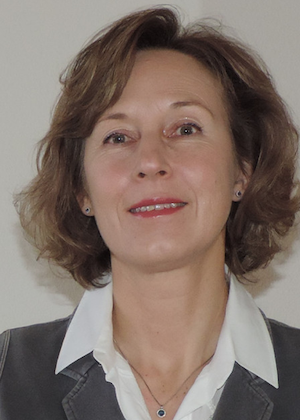
Joanna Hoszowska
|
|
The 17th General Assembly (GA) meeting of the European Synchrotron and FEL User Organisation (ESUO) was held online on 16 May 2022. Romania was accepted as a new ESUO member country and Prof. Dr. Ovidiu Crisan (National Institute of Materials Physics, Romania) was elected as Romanian representative within ESUO. Other relevant discussion topics included (i) the presentation and discussion of the outcome of the ESUO user survey on the possible impacts of the absence of transnational access (TNA) funding support for the user community after the finalization of the European H2020 CALIPSOplus project at the end of October 2021, (ii) an update on the strategic partnership between ESUO and the League of European Accelerator-based Photon Sources (LEAPS), and (iii) information on the draft Horizon Europe Research Infrastructures Work Programme for 2023, 2024. The next ESUO GA meeting is scheduled on 29, 30 August 2022 at the SOLEIL synchrotron in France, with the administrative and financial support of LEAPS.
Moreover, a joint lobbying action was conducted in May 2022 by ESUO and the European Neutron scattering Association ENSA national representatives, towards the national contact points and Research Infrastructures committee members. Following that action, the ESUO president and vice-president attended the launch event of the LEAPS European Strategy on Accelerator-based Photon Sources (ESAPS 2022) held in Brussels on 31 May 2022.
From 1 April 2022 most safety measures against COVID-19 have been lifted at PSI. Please look at updated information here!
We encourage all members of the PSI user community to contact us regarding any issues that concern user operation at PSI.
Yours sincerely,
Joanna Hoszowska
on behalf of the JUSAP panel
|
|
|
|